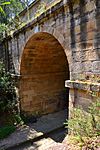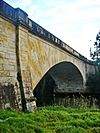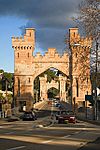Historic bridges of New South Wales facts for kids
This article is about old bridges in New South Wales, Australia. It lists bridges for cars, trains, and people walking. Most of these bridges were built before World War II (1939).
Contents
Building Bridges in New South Wales
Building bridges in New South Wales started because the first settlers needed them. Over time, bridge building got much better. At first, people didn't have many tools or materials. But as time passed, they learned new ways to build. They also found better materials. This helped them cross bigger rivers and reach new areas.
The NSW Public Works Department was in charge of building roads and bridges. The government didn't have much money. So, they wanted bridges built as cheaply as possible. The cheapest bridges were often made of local timber. These were called timber truss bridges.
Every bridge is special. How a bridge is built depends on the tools, skills, and materials available. It also depends on where people need to go.
When Australia was first settled in 1788, it was far from Europe and North America. This meant new building ideas and materials like cast iron were hard to get. Builders in NSW had to be clever and use what they had.
New South Wales has tricky rivers. They can have very little water most of the year. But then, big floods can happen about once every ten years. Early settlers often built simple bridges. But these would often wash away in heavy rain. The government realized this was stopping the area from growing.
To fix these problems, NSW builders learned from others. They also found ways to make new ideas work for Australia's unique conditions. For example, some amazing 19th-century railway bridges were built. These were designed by British engineers working far from home. Today, NSW also has modern cable-stayed bridges.
Australia grew around towns near the coast. Roads to inland towns were very basic. Early bridges often used 18th-century European ideas. These included masonry arches (stone arches) and cast iron. But cast iron was new and not made much in NSW.
In the early days, NSW had many convict labourers. There was a big need to build things quickly. Since there was a lot of timber, basic wooden bridges were common. But as the colony grew, people wanted stronger bridges. As skills for cutting and shaping stone improved, stone bridges were designed. Metal materials had to be imported. So, iron bridges were rare. They were only used for very important crossings.
Timber truss bridges were so common that NSW was known as the "timber bridge state."
The list below shows how bridge building in New South Wales changed over time. It starts with the oldest bridges and moves to newer ones.
Historic Bridges in New South Wales
Sorted by when they were built
| Built | Name | Location | Image | Construction type | Length | Use | In use | Comments | Ref | Coords |
|---|---|---|---|---|---|---|---|---|---|---|
| 1833 | Lennox Bridge | Glenbrook |  |
stone arch | 6 metres (20 ft) | Road | Yes | see article | 33°45′15″S 150°37′56″E / 33.75417°S 150.63222°E | |
| 1836 | Lansdowne Bridge | Lansvale |  |
stone arch | 33.5 m | Road | Yes | Largest stone arch bridge in Australia. | 33°53′24″S 150°58′01″E / 33.89000°S 150.96694°E | |
| 1839 | Lennox Bridge | Parramatta |  |
stone arch | 27 metres (89 ft) | Road | Yes | 33°48′39″S 150°00′16″E / 33.81083°S 150.00444°E | ||
| 1858 | Pyrmont Bridge | Darling Harbour |  |
Ironbark timber with steel centre swing span | 369 metres (1,211 ft) | Road | Yes | One of the largest swing bridges in the world when built. It was also one of the first to use electricity. Now for people walking and bikes only. | 33°52′14″S 151°12′02″E / 33.87056°S 151.20056°E | |
| 1863 | Picton Viaduct | Picton |  |
stone arch | Rail | Yes | Crosses Stonequarry Creek. | 34°10′40″S 150°36′42″E / 34.17778°S 150.61167°E | ||
| 1863 | Menangle Railway Bridge | Menangle |  |
Rail | Yes | see article | 34°07′05″S 150°44′37″E / 34.11806°S 150.74361°E | |||
| 1867 | Victoria Bridge | Penrith |  |
wrought iron girder | Road | Yes | Also known as Nepean River Bridge. | see article | 33°44′46″S 150°40′54″E / 33.74611°S 150.68167°E | |
| 1867 | Knapsack Viaduct | Lapstone |  |
stone arch | Rail (Later road) |
Yes | Now for people walking only. | see article | 33°46′00″S 150°37′00″E / 33.76667°S 150.61667°E | |
| 1867 | Prince Alfred Bridge | Gundagai |  |
underslung wrought iron Warren continuous truss & timber approaches | 921 metres (3,022 ft) | Road | No | Possibly the oldest iron truss bridge in NSW. | 35°04′25″S 148°06′26″E / 35.07361°S 148.10722°E | |
| 1869 | Zig Zag Viaducts | Clarence |  |
Stone | Rail | Yes | 33°28′19″S 150°11′43″E / 33.471939°S 150.195326°E | |||
| 1869 | Farmers Creek Viaduct | Bowenfels | Stone | Rail | No | 33°28′22″S 150°07′38″E / 33.472773°S 150.127141°E | ||||
| 1870 | Marrangaroo Creek Viaduct | Marrangaroo | Stone | Rail | No | 33°26′17″S 150°06′44″E / 33.438177°S 150.112180°E | ||||
| 1870 | Denison Bridge | Bathurst | steel American Pratt truss | Road | Yes | Now for people walking only. | see article | 33°25′02″S 149°35′31″E / 33.41722°S 149.59194°E | ||
| 1870 | Mudgee Road Bridge | Wallerawang | Stone | Road | Yes (private) | 33°24′47″S 150°05′54″E / 33.412946°S 150.098262°E | ||||
| 1870 | Coxs River Bridge | Wallerawang | Stone | Rail | No | 33°24′20″S 150°04′59″E / 33.405507°S 150.083188°E | ||||
| 1874 | Windsor Bridge | Windsor | Road | Yes | 33°36′11″S 150°49′20″E / 33.603163°S 150.822183°E | |||||
| 1881 | Nowra Bridge | Nowra |  |
Steel Whipple Truss | 342 metres (1,122 ft) | Road | Yes | see article | 34°51′51″S 150°36′07″E / 34.86417°S 150.60194°E | |
| 1881 | Gladesville Bridge (the 1881 bridge) | Drummoyne |  |
Road | No | Taken down when the new road bridge opened in 1964. | see article | 33°50′32″S 151°08′35″E / 33.84222°S 151.14306°E | ||
| 1881 | Dubbo Rail Bridge | Dubbo |  |
wrought iron lattice girder bridge | Rail | Yes | 32°14′38″S 149°35′39″E / 32.24389°S 149.59417°E | |||
| 1882 | Peel River Bridge | Tamworth | iron lattice girder | main 159ft - over 3000ft | Rail | Yes | 31°05′06″S 150°55′23″E / 31.084959°S 150.923141°E | |||
| 1885 | Como Bridge (formerly Como Railway Bridge) | Como - Oatley spanning Georges River | lattice girder bridge | Pedestrian, Viaduct (formerly Rail) | Yes | This bridge is important because it was the longest single track lattice girder bridge in NSW. It helped open up Sydney's southern suburbs in the 1880s. It now carries a water pipeline and is a path for people walking across the Georges River. | 33°59′42.3″S 151°04′14.8″E / 33.995083°S 151.070778°E | |||
| 1886 | three trestles | Main North Line | timber Queen post truss viaduct on wooden trestles | Rail | No | Three of only five bridges built. | 29°38′17″S 151°46′50″E / 29.638055°S 151.780665°E29°34′55″S 151°48′09″E / 29.581967°S 151.802520°E29°12′01″S 152°01′00″E / 29.200395°S 152.016721°E | |||
| 1886 | Meadowbank Bridge | Meadowbank |  |
Truss Bridge | Rail | Yes | Now for bikes and people walking only. A new John Whitton Bridge was built in 1980. | 33°49′19″S 151°05′20″E / 33.82194°S 151.08889°E | ||
| 1888 | Brewarrina Bridge | Brewarrina | wrought iron lift bridge with timber beam approaches | 91 metres (299 ft) | Road | Yes | Now for people walking only. | 29°56′51″S 146°51′48″E / 29.94750°S 146.86333°E | ||
| 1888 | Mulga St Bridge | Oatley | Double stone culvert | Road | Yes | The stonework is still visible from Myles Dunphy Reserve, even though it's covered by a modern road. | 33°58′49.8″S 151°4′40.0″E / 33.980500°S 151.077778°E | |||
| 1888 | Sunnyside | Tenterfield | timber Queen post truss viaduct on stone trestles | rail | no | 28°59′08″S 151°56′58″E / 28.985426°S 151.949414°E | ||||
| 1891 | Murrumbidgee River Rail | Wagga Wagga |  |
wrought iron lattice truss | Rail | No | Removed in 2007. | see article | 35°6′56.53″S 147°22′58.16″E / 35.1157028°S 147.3828222°E | |
| 1895 | Wilcannia Bridge | Wilcannia | steel truss bridge | Road | No | You can still visit it. It used to carry the Barrier Highway over the Darling River. | 31°33′36.7″S 143°22′46.7″E / 31.560194°S 143.379639°E | |||
| 1895 Mar | Tharwa Bridge | Tharwa | wooden Allan Truss | Road | Yes | see article | 35°30′31″S 149°04′14″E / 35.508579°S 149.070539°E | |||
| 1895 Nov | Hampden Bridge | Wagga Wagga |  |
wooden Allan Truss | 100.5 metres (330 ft) | Road | Yes | Closed to the public. It was planned to be taken down in 2013. | see article | 35°6′2.53″S 147°22′6.68″E / 35.1007028°S 147.3685222°E |
| 1897 | Victoria Bridge | Picton | wooden Allan Truss | 80 metres (260 ft) | Road | Yes | Tallest trestle (support structure) in NSW. | see article | 34°10′49″S 150°36′38″E / 34.18028°S 150.61056°E | |
| 1897 | Wallaby Rocks Bridge (Turon River) | Wallaby Rocks | Allan timber truss | 106.7 metres (350 ft) | Road | Yes | 33°04′26″S 149°38′59″E / 33.07389°S 149.64972°E | |||
| 1898 | Hampden Bridge | Kangaroo Valley |  |
suspension with sandstone turrets | Road | Yes | see article | 34°43′40″S 150°31′16″E / 34.72778°S 150.52111°E | ||
| 1898 | Morpeth Bridge | Morpeth | Allan truss | 820 feet (250 m) | Road | Yes | see article | 32°43′26″S 151°37′36″E / 32.7237684729°S 151.6265683110°E | ||
| 1901 | Hinton Bridge | Hinton | Allan truss | 178.6 metres (586 ft) | Road | Yes | 32°42′51″S 151°38′52″E / 32.71417°S 151.64778°E | |||
| 1901 | De Burghs Bridge (the 1901 bridge) | West Pymble |  |
Road | No | Replaced by a new road bridge in 1967. The old bridge was destroyed by a bushfire in January 1994. | see article | 33°46′32.8″S 151°8′12″E / 33.775778°S 151.13667°E | ||
| 1902 | Gundagai Rail Bridge | Gundagai |  |
timber Howe deck trusses | 819 metres (2,687 ft) | Rail | No | Crosses over the Murrumbidgee River. | 33°04′23″S 148°06′17″E / 33.07306°S 148.10472°E | |
| 1903 | St Albans Bridge | St Albans |  |
DeBurgh timber truss | Road | Yes | 33°17′39″S 150°58′22″E / 33.29417°S 150.97278°E | |||
| 1903 | Maldon suspension bridge | Maldon | Road | No | 34°12′08″S 150°37′56″E / 34.202084°S 150.632313°E | |||||
| 1911 | Scabbing Flat Bridge | Dubbo | timber 'dare type' truss | Road | Yes | 32°25′50″S 148°48′36″E / 32.430650°S 148.809958°E | ||||
| 1914 | Mungindi Bridge | Mungindi |  |
timber 'dare type' truss | Road | Yes | A new bridge is being built to replace it. | 28°58′33″S 148°59′05″E / 28.97583°S 148.98472°E | ||
| 1916 | Rawsonville Bridge | Dubbo | timber 'dare type' truss | Road | Yes | 32°11′28″S 148°26′59″E / 32.191235°S 148.449709°E | ||||
| 1918 | Fullers Bridge | Chatswood West |  |
Road | Yes | see article | 33°47′34″S 151°09′25″E / 33.79278°S 151.15694°E | |||
| 1924 | Mulwala Bridge | Mulwala |  |
Steel Pratt Truss | Road | Yes | see article | 36°00′15″S 146°00′15″E / 36.00417°S 146.00417°E | ||
| 1924 | Roseville Bridge (the 1924 bridge) | Roseville Chase | Road | No | Replaced by a new road bridge in 1966. It was used as a pedestrian bridge until it was taken down in 1974. | see article | 33°46′27″S 151°12′18.5″E / 33.77417°S 151.205139°E | |||
| 1927 | Subway Lane bridge | Homebush | Rail | Yes | 33°51′58″S 151°05′02.5″E / 33.86611°S 151.084028°E | |||||
| 1929 | Tom Uglys Bridge (the 1929 bridge) | Blakehurst |  |
Truss bridge | 499 metres (1,637 ft) | Road | Yes | see article | 34°00′12″S 151°06′48″E / 34.00336111°S 151.1133778°E | |
| 1932 | Sydney Harbour Bridge | Sydney |  |
steel through arch bridge | Road | Yes | see article | 33°51′29″S 151°12′39″E / 33.85806°S 151.21083°E | ||
| 1932 | Grafton | Grafton |  |
Bascule | Road (upper deck) and Rail (lower deck) | Yes | see article | 29°41′52.6″S 152°56′31.5″E / 29.697944°S 152.942083°E | ||
| 1935 | Ryde Bridge (the 1935 bridge) | Ryde |  |
lift bridge | Road | Yes | see article | 33°49′25″S 151°05′42″E / 33.82361°S 151.09500°E | ||
| 1939 | Long Gully Bridge (Northbridge) | Northbridge |  |
concrete arch | Road | Yes | This bridge was rebuilt and replaced an older bridge from 1892. | 33°48′59″S 151°12′44″E / 33.81639°S 151.21222°E |
Allan Truss Bridges
The Allan truss bridge is named after Percy Allan. He was a famous Australian engineer. His bridge design used both timber (wood) and iron parts. The timber parts were designed to be pushed together (compression). The iron parts were designed to be pulled apart (tension).
Allan's design came after a lot of testing. Professor Warren and his students at Sydney University tested Australian hardwoods (strong timbers). They found that ironbark wood was very strong.
Other good things about Allan's design:
- It needed less maintenance later on.
- It was easier to replace parts.
- The trusses were built in pairs. This meant workers could fix one part without needing to support the whole bridge. This was a big improvement from older timber designs.
- Allan's design was also very cost-effective, meaning it saved money.
The Hampden Bridge in New South Wales was one of the first larger bridges built using Percy Allan’s design. The Tharwa Bridge was built even earlier using his design.
Dare Truss Bridges
Harvey Dare was another important engineer in New South Wales in the early 1900s. He worked for the Public Works Department. He designed bridges and created the "Dare Truss."
The Dare Truss was similar to the Allan Truss. But it had improvements that made it stronger. It was also easier to maintain. These changes were a big step forward in timber truss bridge design. This makes Dare trusses very important in engineering history.
In 1998, 27 out of the 40 Dare trusses built in NSW were still standing. Overall, 82 timber truss road bridges were still around, out of more than 400 that had been built.


